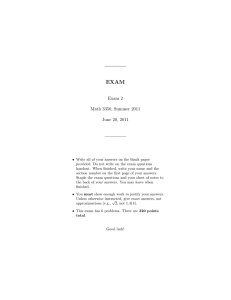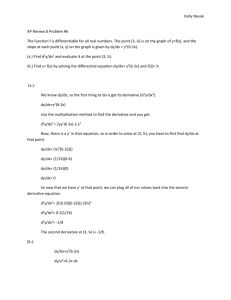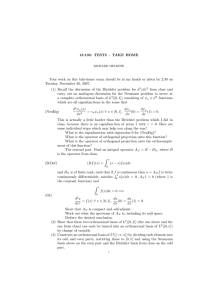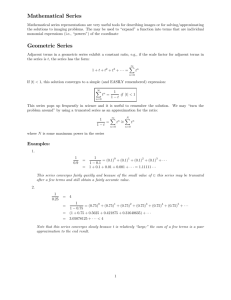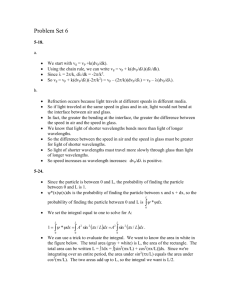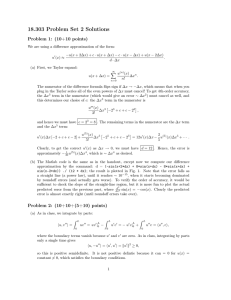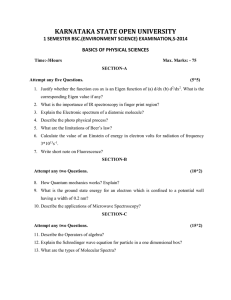Electronic Journal of Differential Equations, Vol. 2014 (2014), No. 153,... ISSN: 1072-6691. URL: or
advertisement
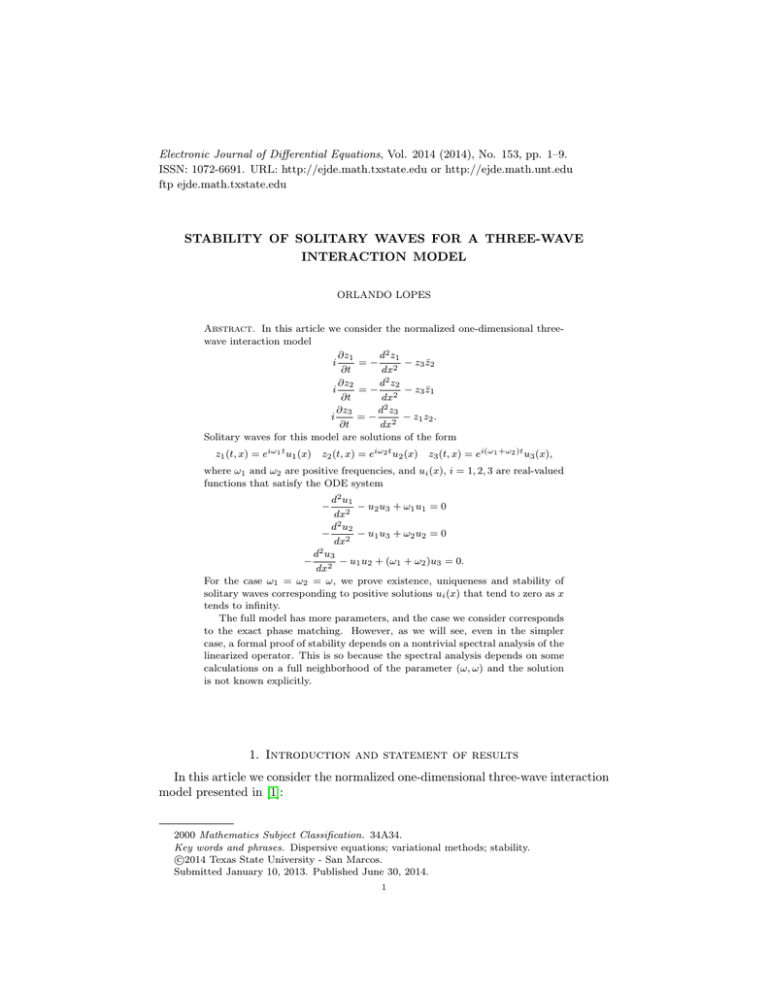
Electronic Journal of Differential Equations, Vol. 2014 (2014), No. 153, pp. 1–9.
ISSN: 1072-6691. URL: http://ejde.math.txstate.edu or http://ejde.math.unt.edu
ftp ejde.math.txstate.edu
STABILITY OF SOLITARY WAVES FOR A THREE-WAVE
INTERACTION MODEL
ORLANDO LOPES
Abstract. In this article we consider the normalized one-dimensional threewave interaction model
∂z1
d 2 z1
i
=−
− z3 z̄2
∂t
dx2
d 2 z2
∂z2
=−
− z3 z̄1
i
∂t
dx2
2
∂z3
d z3
i
=−
− z1 z2 .
∂t
dx2
Solitary waves for this model are solutions of the form
z1 (t, x) = eiω1 t u1 (x)
z2 (t, x) = eiω2 t u2 (x)
z3 (t, x) = ei(ω1 +ω2 )t u3 (x),
where ω1 and ω2 are positive frequencies, and ui (x), i = 1, 2, 3 are real-valued
functions that satisfy the ODE system
d2 u1
− u2 u3 + ω1 u1 = 0
dx2
2
d u2
−
− u1 u3 + ω2 u2 = 0
dx2
2
d u3
− u1 u2 + (ω1 + ω2 )u3 = 0.
−
dx2
For the case ω1 = ω2 = ω, we prove existence, uniqueness and stability of
solitary waves corresponding to positive solutions ui (x) that tend to zero as x
tends to infinity.
The full model has more parameters, and the case we consider corresponds
to the exact phase matching. However, as we will see, even in the simpler
case, a formal proof of stability depends on a nontrivial spectral analysis of the
linearized operator. This is so because the spectral analysis depends on some
calculations on a full neighborhood of the parameter (ω, ω) and the solution
is not known explicitly.
−
1. Introduction and statement of results
In this article we consider the normalized one-dimensional three-wave interaction
model presented in [1]:
2000 Mathematics Subject Classification. 34A34.
Key words and phrases. Dispersive equations; variational methods; stability.
c
2014
Texas State University - San Marcos.
Submitted January 10, 2013. Published June 30, 2014.
1
2
O. LOPES
EJDE-2014/153
∂z1
d2 z1
= − 2 − z3 z̄2
∂t
dx
∂z2
d2 z2
(1.1)
i
= − 2 − z3 z̄1
∂t
dx
∂z3
d2 z3
i
= − 2 − z1 z2 .
∂t
dx
Here, x ∈ R, zi (t, x), i = 1, 2, 3 are complex values and z̄i denotes the conjugate of
zi .
In [2] a model with more nonlinear terms and more space variables is analyzed.
In that case, the authors are able to study the stability/instability of solitary waves
with only one nonzero component. In [3], the stability of a semitrivial standing wave
for a system of two Schrodinger equations in several space variables is discussed.
The model considered here is this paper is one dimensional in the space variable
and the components of the solitary waves are nonzero.
System (1.1) has the following conserved quantities:
i=3 Z
Z +∞
1 X +∞ dzi (x) 2
0
E (z1 , z2 , z3 ) =
|
| dx − Re
z1 (x)z2 (x)z̄3 (x) dx
(1.2)
2 i=1 −∞
dx
−∞
Z
1 +∞
0
Q1 (z1 , z3 ) =
(|z1 (x)|2 + |z3 (x)|2 ) dx
(1.3)
2 −∞
Z
1 +∞
(|z2 (x)|2 + |z3 (x)|2 ) dx
(1.4)
Q02 (z2 , z3 ) =
2 −∞
i
Solitary waves of (1.1) are solutions of the form
z1 (t, x) = eiω1 t u1 (x) z2 (t, x) = eiω2 t u2 (x) z3 (t, x) = ei(ω1 +ω2 )t u3 (x) ,
(1.5)
where the frequencies ωI are positive values, and ui (x) are real-value functions for
i = 1, 2, 3. Therefore, the ui (x)s have to satisfy the ODE system
d2 u1
− u2 u3 + ω1 u1 = 0
dx2
d2 u2
− 2 − u1 u3 + ω2 u2 = 0
dx
2
d u3
− 2 − u1 u2 + (ω1 + ω2 )u3 = 0 .
dx
−
(1.6)
Defining
i=3
E(u1 , u2 , u3 ) =
Z +∞
dui (x) 2
dx −
u1 (x)u2 (x)u3 (x) dx
dx
−∞
−∞
Z
1 +∞ 2
Q1 (u1 , u3 ) =
(u (x) + u23 (x)) dx
2 −∞ 1
Z
1 +∞ 2
Q2 (u2 , u3 ) =
(u (x) + u23 (x)) dx
2 −∞ 2
1X
2 i=1
Z
+∞
we see that solutions of (1.6) are critical points of
E(u1 , u2 , u3 ) + ω1 Q1 (u1 , u3 ) + ω2 Q2 (u2 , u3 ).
(1.7)
(1.8)
(1.9)
EJDE-2014/153
STABILITY OF SOLITARY WAVES
3
By a positive solution of system (1.6) we mean a solution (u1 (x), u2 (x), u3 (x))
defined for all x ∈ R such that ui (x) > 0 for all x, and ui (x) tends to zero exponentially as |x| approaches infinity, i = 1, 2, 3 (this implies that the derivatives also
tend to zero).
Let H = H 1 (R, C) × H 1 (R, C) × H 1 (R, C) be the space of the complex valued
functions z(x) = (z1 (x), z2 (x), z3 (x)) defined for x ∈ R with norm
3 Z +∞
3 Z +∞
X
X
dzi (x) 2
kzk2 =
|
| dx +
|zi (x)|2 dx.
dx
−∞
−∞
i=1
i=1
We denote by u(x) = (u1 (x), u2 (x), u3 (x)) a solution of (1.6) in the space H.
Definition 1.1. The solitary wave (1.5) is orbitally stable with respect to system
(1.1) if for each > 0 there is a δ > 0 such that if z0 ∈ H and kz0 − uk < δ then
the solution z(t) of (1.1) with z(0) = z0 satisfies
sup
−∞<t<+∞
inf{kz(t)−(eiθ1 u1 (·+c), eiθ2 u2 (·+c), ei(θ1 +θ2 ) u3 (·+c)k, θ1 , θ2 , c ∈ R}) < .
In the definition of orbital stability, the supremum is taken over −∞ < t < +∞
because we are dealing with conservative systems and the Cauchy problem is well
posed for all values of t. Next we state our main results.
Theorem 1.2. The following assertions hold:
(1) For any ω1 , ω2 > 0 system (1.6) has a positive solution that tends to zero
exponentially.
(2) Except for a translation in the x variable (the same translation for all components), any positive solution of (1.6) is symmetric and decreasing.
(3) If ω1 = ω2 then the solution (u1 , u2 , u3 ) given in part one satisfies u1 = u2 ,
it is unique and the linearized operator L = (L1 , L2 , L3 ) where
d2 h1
− u3 h2 − u2 h3 + ω1 h1
dx2
d2 h2
L2 (h1 , h2 , h3 ) = − 2 − u3 h1 − u1 h3 + ω2 h2
dx
d2 h3
L3 (h1 , h2 , h3 ) = − 2 − u2 h1 − u1 h2 + ω3 h3
dx
L1 (h1 , h2 , h3 ) = −
(1.10)
has zero as a simple eigenvalue corresponding to (u01 (x), u02 (x), u03 (x)), as eigenfunction, and it has exactly one negative eigenvalue. Moreover, such a solution gives
rise to an orbitally stable solitary wave of the evolution system (1.1).
Remark 1.3. In the case ω1 = ω2 = ω, u1 = u2 = u, u3 = v system (1.6) becomes
d2 u
− uv + ωu = 0
dx2
d2 v
− 2 − u2 + 2ωv = 0.
dx
−
(1.11)
System (1.11) possesses no explicit solutions (u, v) of the form (sech2 , sech2 ),
(sech2 , sech), (sech, sech2 ), (sech, sech). In [5] a model with more parameters is
considered. In that case, explicit solutions are given. However, in the case we are
considering here, those solutions become that trivial one.
4
O. LOPES
EJDE-2014/153
2. Proof of main results
The proof of Throem 1.2 will be broken in several lemmas the first of which deals
with the existence of positive solution.
Lemma 2.1. System (1.6) has a C ∞ positive solution that tends to zero exponentially as x tends to infinity.
Proof. For ui ∈ H 1 (R), i = 1, 2, 3, we minimize E(u1 , u2 , u3 ) under
ω1 Q1 (u1 , u2 , u3 ) + ω2 Q2 (u1 , u2 , u3 ) = 1,
where E(u1 , u2 , u3 ), Q1 (u1 , u2 , u3 ) and Q2 (u1 , u2 , u3 ) are defined by (1.7), (1.8)
and (1.9). The existence of a minimizer follows from the method of concentration
compactness ([7]). The corresponding Euler-Lagrange equation has a multiplier
that can be absorbed by a scaling argument. Since E(u1 , u2 , u3 ) does not increase
if we replace (u1 , u2 , u3 ) by (|u1 |, |u2 |, |u3 |) we can assume that the components
are nonnegative. The maximum principle implies that each component is actually
strictly positive. The exponential decay follows from linearization at (0, 0, 0).
The assertion concerning the symmetry is a Gidas-Ni-Nirenberg-Troy-type result
and its proof in the one dimensional case has been given in [6]. This completes the
proof.
Lemma 2.2. If ω1 = ω2 = ω then the solution (u1 , u2 , u3 ) given by the previous lemma satisfies u1 = u2 and it is unique. Moreover the linearized operator
L = (L1 , L2 , L3 ) given by (1.10) at that solution has zero as a simple eigenvalue
corresponding to the eigenfunction (u01 (x), u02 (x), u03 (x)) and it has exactly one negative eigenvalue.
Proof. If ω1 = ω2 = ω, systems (1.6) becomes
d2 u1
− u2 u3 + ωu1 = 0
dx2
d2 u2
− 2 − u1 u3 + ωu2 = 0
dx
d2 u3
− 2 − u1 u2 + 2ωu3 = 0
dx
−
(2.1)
and then
d2 (u1 − u2 )
+ u3 (u1 − u2 ) + ω(u1 − u2 ) = 0.
dx2
If we multiply this last equality by (u1 − u2 ) and integrate we see that we must
have u1 = u2 . Setting u1 = u2 = u and u3 = v, we get the system
−
d2 u
− uv + ωu = 0
dx2
(2.2)
d2 v
− 2 − u2 + 2ωv = 0.
dx
Notice
that
system
(1.6)
is
variational
but (2.2) is not. We fix that defining
√
U = 2u, V = v. Then (2.2) takes the variational form
−
d2 U
− U V + ωU = 0
dx2
d2 V
U2
− 2 −
+ 2ωV = 0.
dx
2
−
(2.3)
EJDE-2014/153
STABILITY OF SOLITARY WAVES
5
Next we define the linearized operator M (h, k) = (M1 (h, k), M2 (h, k) of (2.3) where
d2 h
− U k − V h + ωh
dx2
(2.4)
d2 k
M2 (h, k) = − 2 − U h + 2ωk.
dx
According to [8] and [9], the positive solution of (2.3) is unique, the linearized operator M = (M1 , M2 ) has zero as a simple eigenvalue corresponding to the eigenfunction (U 0 , V 0 ) and it has exactly one negative eigenvalue.
Now let λ ≤ 0 be an eigenvalue of L = (L1 , L2 , L3 ) defined by (1.10), with
eigenfunction (h1 , h2 , h3 ). Then
M1 (h, k) = −
d2 h1
− vh2 − uh3 + ωh1 − λh1 = 0
dx2
d2 h2
− 2 − vh1 − uh3 + ωh2 − λh2 = 0.
dx
d2 h3
− 2 − uh1 − uh2 + 2ωh3 − λh3 = 0.
dx
Defining p = h1 − h2 and using the first two equations of (2.5) we get
−
(2.5)
d2 p
+ vp + ωp − λp = 0.
dx2
Multiplying this last equation by p and integrating we get p = 0 (because λ ≤ 0).
In other words, if λ ≤ 0 is an eigenvalue of L with eigenfunction (h1 , h2 , h3 ) then
we must have h1 = h2 . Setting h1 = h2 = h and h3 = k, system (2.5) becomes
−
d2 h
− vh − uk + ωh − λh = 0
dx2
(2.6)
d2 k
− 2 − 2uh + 2ωk − λk = 0.
dx
√
As before, (2.6) is not selfadjoint and then we define H = 2h and K = k, and
(2.6) becomes
d2 H
− 2 − U K − V H + ωH − λH = 0
dx
(2.7)
d2 K
− 2 − U H + 2ωK − λK = 0.
dx
Notice that (2.7) is precisely the equation for the eigenvalues of the linearized
operator M = (M1 , M2 ) defined by (2.4). The conclusion is: if ω1 = ω2 and
λ ≤ 0 is an eigenvalue of L = (L1 , L2 , L3 ) defined by (1.10) with eigenfunctions
(h1 , h2 , h3 ), then h1 = h2√and λ is an eigenvalue of M = (M1 , M2 ) defined by (2.4)
with eigenfunction (h1 / 2, h3 ). Therefore, the spectral properties of L claimed
in lemma follow from the spectral properties of M stated above. The proof is
complete.
−
Next we discuss the stability of the solitary wave in the sense of Definition 1.1.
If we fix an ω > 0, then according to Lemma 2.2, zero is a simple eigenvalue of the
operator L and the corresponding eigenfuntion is odd. Since the coefficients of L are
even, the set of even functions is invariant under L. Consequently, L is invertible
in the class of even functions because the only eigenfunction of L corresponding to
the zero eigenvalue is odd. Therefore, from the implicit function theorem, there
6
O. LOPES
EJDE-2014/153
is a smooth family ui (ω1 , ω2 ), i = 1, 2, 3 of positive symmetric solution of (1.6) for
(ω1 , ω2 ) in a neighborhood of (ω, ω). We define
Q1 (ω1 , ω2 ) = Q1 (u1 (ω1 , ω2 ), u3 (ω1 , ω2 ))
and
Q2 (ω1 , ω2 ) = Q2 (u2 (ω1 , ω2 ), u3 (ω1 , ω2 )),
where Q1 (u1 , u3 ) and Q2 (u2 , u3 ) are defined by (1.8) and (1.9), respectively. According to [4] and due to the spectral properties of the operator L, the solitary
wave (1.5) is orbitally stable provided the matrix
!
A(ω1 , ω2 ) =
∂Q1 (ω1 ,ω2 )
∂ω1
∂Q2 (ω1 ,ω1 )
∂ω1
∂Q1 (ω1 ,ω2 )
∂ω2
∂Q2 (ω1 ,ω2 )
∂ω2
(2.8)
has exactly one negative eigenvalue; that is, if
det A(ω1 , ω2 ) < 0.
(2.9)
As we have seen, for ω1 = ω2 = ω, the positive symmetric solution of (1.6) is
(u1 , u2 , u3 ) with u1 = u2 = u, u3 = v and
d2 u
− uv + ωu = 0
dx2
(2.10)
d2 v
− 2 − u2 + 2ωv = 0.
dx
If we denote by (φ, ψ) the solution of (2.10) corresponding to ω = 1, then the
unique positive symmetric solution of (2.10) is
√
√
u(x) = ωφ( ωx), , v(x) = ωψ( ωx).
−
If we set
Z
+∞
I=
(φ(x)2 + ψ(x)2 ) dx
−∞
then
Q1 (ω, ω) = Q2 (ω, ω) = ω 3/2 I.
Differentiating (2.11) with respect to ω we get
3
∂Q1 (ω, ω) ∂Q1 (ω, ω)
+
= ω 1/2 I
∂ω1
∂ω2
2
∂Q2 (ω, ω) ∂Q2 (ω, ω)
3
+
= ω 1/2 I.
∂ω1
∂ω2
2
(2.11)
(2.12)
Remark 2.3. Notice that even in the case ω1 = ω2 , if the quantities Qi (β1 , β2 ), i =
1, 2 were known explicitly in terms of β1 and β2 in a full neighborhood of (ω, ω),
then the verification of condition (2.9) would be easy. As we will see, the matrix
A(ω1 , ω2 ) is symmetric. Therefore, the scaling invariance gives us two equations
(2.12) involving three quantities. Due to that, the verification of (2.9) requires
further analysis that will be carried out next.
Define
∂u1 (x, ω, ω)
,
∂ω1
∂u2 (x, ω, ω)
U21 (x) =
,
∂ω1
U11 (x) =
∂u1 (x, ω, ω)
,
∂ω2
∂u2 (x, ω, ω)
U22 (x) =
,
∂ω2
U12 (x) =
EJDE-2014/153
STABILITY OF SOLITARY WAVES
U31 (x) =
∂u3
,
∂ω1
U32 =
7
∂u3
,
∂ω2
and differentiate with respect to ω1 and ω2 in a neighborhood of (ω, ω). We obtain
d2 U11
− u3 U21 − u2 U31 + ω1 U11 = −u1
dx2
d2 U21
−
− u3 U11 − u1 U31 + ω2 U21 = 0
dx2
d2 U31
− u1 U21 − u2 U11 + (ω1 + ω2 )U31 = −u3
−
dx2
−
(2.13)
and
d2 U12
− u3 U22 − u2 U32 + ω1 U12 = 0
dx2
d2 U22
(2.14)
−
− u3 U12 − u1 U32 + ω2 U22 = −u2
dx2
d2 U32
−
− u1 U22 − u2 U12 + (ω1 + ω2 )U32 = −u3
dx2
Setting ω1 = ω2 = ω, u1 = u2 = u and u3 = v, Equations (2.13) and (2.14) become
−
d2 U11
− vU21 − uU31 + ωU11 = −u
dx2
d2 U21
−
− vU11 − uU31 + ωU21 = 0
dx2
d2 U31
− uU21 − uU11 + 2ωU31 = −v
−
dx2
−
(2.15)
and
d2 U12
− vU22 − uU32 + ωU12 = 0
dx2
2
d U22
− vU12 − uU32 + ωU22 = −u
−
dx2
d2 U32
−
− uU22 − uU12 + 2ωU32 = −v.
dx2
Interchanging the first two equations of (2.16) we obtain
−
d2 U22
− vU12 − uU32 + ωU22 = −u
dx2
d2 U12
−
− vU22 − uU32 + ωU12 = 0
dx2
d2 U32
−
− uU22 − uU12 + 2ωU32 = −v.
dx2
Comparing (2.17) and (2.15), we see that we must have
(2.16)
−
U11 = U22 ,
U21 = U12 ,
U31 = U32 ,
(2.17)
(2.18)
because, as we have seen, the operator L is invertible in the space of even functions.
Furthermore, from (1.8) and (1.9) we have
Z ∞
Z ∞
∂Q1 (ω1 , ω2 )
∂Q1 (ω1 , ω2 )
=2
(u1 U11 + u3 U31 ) dx,
=2
(u1 U12 + u3 U32 ),
∂ω1
∂ω2
−∞
−∞
8
O. LOPES
∂Q2 (ω1 , ω2 )
=2
∂ω1
Z
∞
(u2 U21 + u3 U31 ) dx
−∞
EJDE-2014/153
∂Q2 (ω1 , ω2 )
=2
∂ω2
Z
∞
(u2 U22 + u3 U32 ).
−∞
Setting ω1 = ω2 = ω, u1 = u2 = u and u3 = v and using (2.18) we have
Z ∞
Z ∞
∂Q1 (ω, ω)
∂Q1 (ω, ω)
(uU11 + vU31 ) dx,
(uU12 + vU31 ),
=2
=2
∂ω1
∂ω2
−∞
−∞
Z ∞
Z ∞
∂Q2 (ω, ω)
∂Q2 (ω, ω))
(uU12 + vU31 ) dx,
(uU11 + vU31 ).
=2
=2
∂ω1
∂ω2
−∞
−∞
We conclude that
∂Q1 (ω, ω)
∂Q2 (ω, ω)
=
,
∂ω1
∂ω2
∂Q1 (ω, ω)
∂Q2 (ω, ω)
=
.
∂ω2
∂ω1
This second equality we already knew because the matrix A(ω1 , ω2 ) is symmetric.
Then
∂Q (ω, ω) 2 ∂Q (ω, ω) 2
1
1
det(A(ω, ω)) =
−
∂ω1
∂ω2
∂Q (ω, ω) ∂Q (ω, ω) ∂Q (ω, ω) ∂Q (ω, ω) 1
1
1
1
=
−
+
.
∂ω1
∂ω2
∂ω1
∂ω2
From (2.12) we conclude that
∂Q1 (ω, ω) ∂Q1 (ω, ω)
+
> 0.
∂ω1
∂ω2
Therefore, to show that det(A(ω, ω)) < 0 we have to show that
Z ∞
u(U11 − U12 ) dx < 0.
(2.19)
−∞
Defining W = U11 − U12 , from the first two equations (2.15) and taking in account
that U21 = U12 we see that
d2 W
+ vW + ωW = −u
dx2
and this implies W < 0 (because W cannot have a positive maximum). The proof
of Theorem 1.2 is complete.
−
References
[1] A. Buryak, Y. Kivshar; Multistability of three-wave parametric self trapping, Phys. Rev.
Lett., vol. 78, no. 17, (1997), 3286-3289.
[2] M. Colin, Th. Colin, M. Ohta; Stability of solitary waves for a system o nonlinear equations
with three wave interaction, Ann. Inst. H. Poincaré Anal. Non Linéaire, 26 (2009), 2211-2226.
[3] M. Colin, M. Ohta; Bifurcation from semitrivial standing waves and ground states for a
system of nonlinear Schrodinger equations, SIAM J. Math. Anal., vol. 44, No. 1 (2012),
206-223.
[4] M. Grillakis, J. Shatah, W. Strauss; Stability theory of solitary waves in the presence of
symmetry, II, J. Functional Analysis, 94, 1990,308-348.
[5] G. Huang; Exact solitary wave solutions of three-wave interaction equations with dispersion,
J. Phys. A: Math. Gen. 33 (2000), 8477-8482.
[6] N. Ikoma; Uniqueness of Positive Solution for a Nonlinear Elliptic systems, Nonlinear Differential Equations and Applications, 2009, online.
EJDE-2014/153
STABILITY OF SOLITARY WAVES
9
[7] P. L. Lions; The concentration compactness principle in the Calculus of Variations, AIHP,
Analyse Nonlineaire, part I, vol. 1, no. 2, 1984, 109-145; part II: vol. 1, no4, 1984, 223-283.
[8] O. Lopes; Stability of solitary waves of some coupled systems. Nonlinearity 19 (2006), no. 1,
95-113 .
[9] O. Lopes; Uniqueness of symmetric positive solution of an ODE systems, Eletronic Journal
of Differential Equations, vol. 2009 (2009), no. 162, 1-8.
Orlando Lopes
IMEUSP- Rua do Matao, 1010, Caixa postal 66281, CEP: 05315-970, Sao Paulo, SP, Brazil
E-mail address: olopes@ime.usp.br
